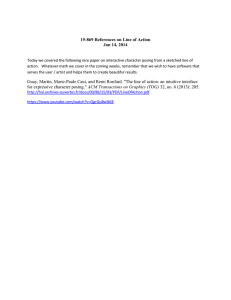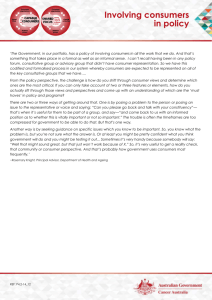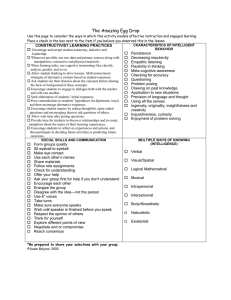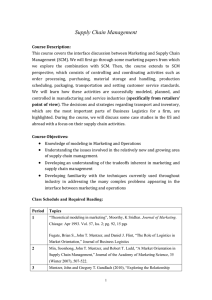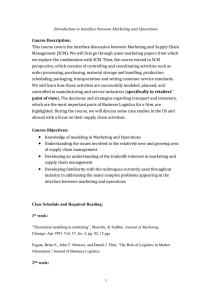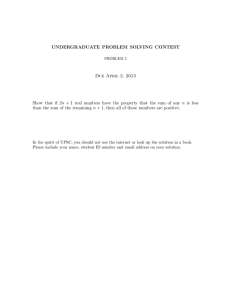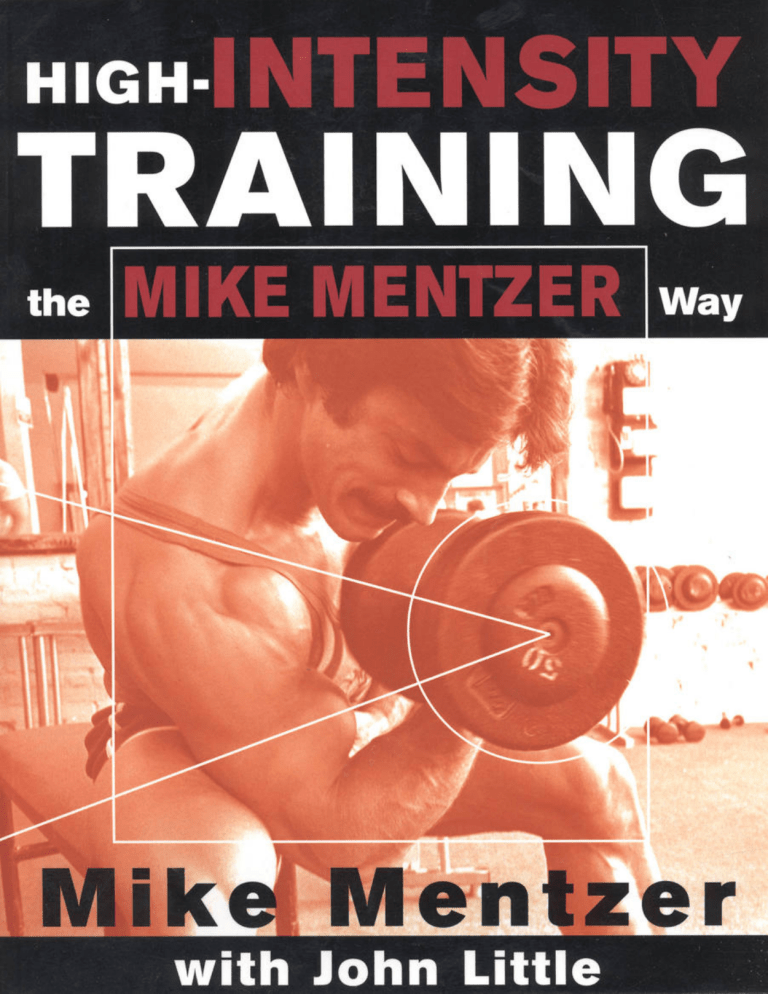
HIGH-INTENSITY TRAINING the Mike Mentzer Way Mike Mentzer with John Little New York Chicago San Francisco Lisbon London Madrid Mexico City Milan New Delhi San Juan Seoul Singapore Sydney Toronto Copyright © 2003 by Mentzer-Sharkey Enterprises, Inc., and John Little. All rights reserved. Except as permitted under the United States Copyright Act of 1976, no part of this publication may be reproduced or distributed in any form or by any means, or stored in a database or retrieval system, without the prior written permission of the publisher. ISBN: 978-0-07-161095-7 MHID: 0-07-161095-2 The material in this eBook also appears in the print version of this title: ISBN: 978-0-07-138330-1, MHID: 0-07-138330-1. All trademarks are trademarks of their respective owners. Rather than put a trademark symbol after every occurrence of a trademarked name, we use names in an editorial fashion only, and to the benefit of the trademark owner, with no intention of infringement of the trademark. Where such designations appear in this book, they have been printed with initial caps. McGraw-Hill eBooks are available at special quantity discounts to use as premiums and sales promotions, or for use in corporate training programs. To contact a representative please e-mail us at bulksales@mcgraw-hill.com. Cover photograph copyright © John Balik Permission to reprint interior photographs has been granted by the following copyright holders: Copyright © John Balik: 12 (right), 43 (right), 49, 52, 63 (bottom), 81 (left), 82, 92 (left), 94, 98, 99,102,120 (left and right), 121 (left and right), 122,123 (right), 126,128 (right), 129,131 (top and bottom), 133,140 (left), 141,143 (left), 145 (top and bottom), 146, 148 (left), 150 (left), 153,161,163,166,171,181,182,188,189,19 0,192,194 (left), 196, 208, 211 (left), 212, 213, 214 Copyright © Robert and Gail Gardner: vii, ix, 5, 8, 32, 34, 37, 53,117,124,128 (left), 138,162,176,177,178,179,1 80,184,194 (right), 197, 210 Copyright © Mike Mentzer Estate: 12 (left), 43 (left), 61,127, 204, 207 (left and right) Copyright © Michael Neveux: vi, xiv, 18, 20, 28, 33, 57, 58, 59, 64, 69, 72, 73, 76, 86, 91 (left and right), 92 (right), 95, 97,104,105 (left and right), 106 (right), 109 (all), 111, 147 (top and bottom), 148 (top right and bottom right), 150 (top right), 155 (left and right), 156,158,159 (top right and bottom right), 164,169,172,174,183,186,198 Copyright © Michael Neveux and John Balik: xii, 2, 3, 6,10,11,14,15 (bottom), 16 (top and bottom), 17,19, 22, 23, 24, 25, 27, 30, 35, 38, 40, 41, 42, 44, 46, 47, 50, 54, 55, 60, 63 (top), 65, 66, 70, 75, 78 (left and right), 79 (top and bottom), 80, 81 (right), 84, 87, 88, 89, 93 (all), 96,100,101,106 (left), 108 (top and bottom), 112,114,115,116,118,119 (top and bottom), 123 (left), 125 (left and right), 130 (left and right), 132 (left and right), 140 (top right and bottom right), 142 (all), 143 (right), 144 (left and right), 149 (top and bottom), 150 (bottom right), 151 (left and right), 152,154,159 (left), 168,170,175 (left and right), 191, 200, 201 (left and right), 202, 203, 205, 206, 211 (right) Copyright © Northern River Productions: page 15 (top), p. 139 This publication is designed to provide accurate and authoritative information in regard to the subject covered. It is sold with the understanding that neither the publisher nor the copyright owners are engaged in rendering medical advice or services. Before starting this or any other exercise and nutritional program, consult with your doctor and obtain a thorough checkup. TERMS OF USE This is a copyrighted work and The McGraw-Hill Companies, Inc. ("McGrawHill") and its licensors reserve all rights in and to the work. Use of this work is subject to these terms. Except as permitted under the Copyright Act of 1976 and the right to store and retrieve one copy of the work, you may not decompile, disassemble, reverse engineer, reproduce, modify, create derivative works based upon, transmit, distribute, disseminate, sell, publish or sublicense the work or any part of it without McGraw-Hill's prior consent. You may use the work for your own noncommercial and personal use; any other use of the work is strictly prohibited. Your right to use the work may be terminated if you fail to comply with these terms. THE WORK IS PROVIDED "AS IS." McGRAW-HILL AND ITS LICENSORS MAKE NO GUARANTEES OR WARRANTIES AS TO THE ACCURACY, ADEQUACY OR COMPLETENESS OF OR RESULTS TO BE OBTAINED FROM USING THE WORK, INCLUDING ANY INFORMATION THAT CAN BE ACCESSED THROUGH THE WORK VIA HYPERLINK OR OTHERWISE, AND EXPRESSLY DISCLAIM ANY WARRANTY, EXPRESS OR IMPLIED, INCLUDING BUT NOT LIMITED TO IMPLIED WARRANTIES OF MERCHANTABILITY OR FITNESS FOR A PARTICULAR PURPOSE. McGraw-Hill and its licensors do not warrant or guarantee that the functions contained in the work will meet your requirements or that its operation will be uninterrupted or error free. Neither McGraw-Hill nor its licensors shall be liable to you or anyone else for any inaccuracy, error or omission, regardless of cause, in the work or for any damages resulting therefrom. McGraw-Hill has no responsibility for the content of any information accessed through the work. Under no circumstances shall McGraw-Hill and/or its licensors be liable for any indirect, incidental, special, punitive, consequential or similar damages that result from the use of or inability to use the work, even if any of them has been advised of the possibility of such damages. This limitation of liability shall apply to any claim or cause whatsoever whether such claim or cause arises in contract, tort or otherwise. To the "new intellectuals": those who are willing to think for themselves and to stand by their decisions; those who believe in principles and act on them; those who seek truth and are willing to share it; those who choose to learn and to educate and who do so in a manner that is both benevolent and ethical. It is to their hands that the torch of Mike Mentzer's legacy is passed, and to them that this book is dedicated. -I.L 26 High-Intensity Training the Mike Mentzer Way day—Casey was only training one hour a day with only three workouts a week! If Casey could develop a physique of his caliber with only three hours of training a week, it struck me that there was still hope that I too might win the Mr. America title some day. My introduction to Casey and his methods of training back in 1971 served to rekindle my waning enthusiasm, and after a forced layoff from 1971 to 1974 because of a serious shoulder injury, I resumed contest training in earnest by the early part of 1975. Having whipped myself into good enough shape, I entered the 1975 Mr. America, placing third behind Robby Robinson and Roger Callard. I knew that in order to come back and win the America in 1976 I would have to improve considerably because the competition promised to be extremely tough, with Callard and Danny Padilla out for blood. As things turned out, I improved myself beyond my wildest expectations that year and went on to win the 1976 Mr. America, taking first on every judge's card! Later, I would learn from Casey's mentor, Arthur Jones (the man who invented the Nautilus exercise machines that were all the rage throughout the '70s and '80s and himself one of the most knowledgeable people I've ever met with regard to muscle physiology), specific absolutes about human response to highintensity stress exercise, specific principles that—once I understood and employed them—allowed me to reduce my training time even more drastically and to increase my results beyond my wildest expectations. When I won the Mr. Universe contest in 1978 (with the only perfect score ever awarded in that competition) and the heavyweight Mr. Olympia title in 1979,1 was training roughly 45 minutes per workout and engaging in only two to three workouts per week. In the past two decades, I have learned even more about exercise science and detected even more fundamental principles that, when integrated with the exercise principles I learned from Jones, have resulted in my seldom advocating a workout that lasts longer than 10 minutes and that would have my clients in the gym no more than once a week. And, like me when I was training for serious competition, my clients are making gains in muscle size and strength with every set of every workout they perform. How is it possible to make such outstanding progress with so little training? By training according to valid principles. For those frustrated bodybuilders who haven't given up; who refuse to allow the flame of their passion for a more muscular body to go out; who have some awareness of the role of facts, logic, and reason in their lives, let me assure you that there is a science of muscle building and that it can be understood by anyone willing to exercise the required effort to understand seven fundamental principles that, taken together, form the matrix of bodybuilding science. On the Need for Principles When Mike Mentzer applied the principles of high-intensity training to his workouts he reduced his training time and increased his results beyond his wildest expectations. 27 Part FUNDAMENTALS II A Compendium of High-Intensity Training Principles The Herculean physique of Mike Mentzer is positive proof of the efficacy of the principles of high-intensity training. 101 Mike Mentzer was a longtime advocate of both free weights and machines throughout his career. His favorite exercise machines were made by Nautilus. Chapter !@ FREE WEIGHTS VS. MACHINES WHICH ARE BETTER? During a lull in one of my workouts recently, I was approached by a well-developed young bodybuilder who wanted to ask "just one question" (which is something no aspiring bodybuilder can possibly do). His one question, of course, led to a lengthy catechism, but I didn't mind as his queries were intelligent and thought-provoking. As we continued our conversation, my interrogator told me he had attended the seminars of practically every top bodybuilder in the world back home in Toronto, Canada. He claimed that even though he did pick up some valuable practical information from a couple of champions, in most cases he left the seminars disappointed. Often contradictory information was dispensed and sometimes even misinformation. "Like what?" I asked. "Why sure, Mike, that's easy," he shot back. "There are so many. Just recently one of the greatest bodybuilders of all time held a seminar in our gym and said something to the effect that to create definition in the frontal thighs you shouldn't perform squats, as they ruin definition, and that thigh extensions were best." "Okay, he was wrong," I replied. "Did you call him on it?" "Yeah, I told him that there was no such thing as a definition exercise or a bulk exercise. I said that because squats activate more muscles, they burn more calories than thigh extensions and will therefore enhance definition faster." "What did the champ say then?" I asked. "Before he could respond, someone in the audience yelled that I was crazy and wanted to know how many titles I had won. The champ then pointed out that he had many more years' experience than me and was obviously more successful. I realized that his seminar was not intended as an open exchange of ideas but a monologue by an egomaniac, so I shut up." I told the young bodybuilder that he had done well in questioning the champ, but that it was probably best not to push the point, and I resumed my workout. However, the attitude typified by the young bodybuilder is one that's 103 104 High-Intensity Training the Mike Mentzer Way becoming increasingly prevalent among strength athletes all over the world. Everywhere truth-seekers are taking a hard critical look at traditional training and dietary practices. No longer do they automatically swallow the advice of a top champ. No longer will they passively bow to the decree "Thou shalt!" They want a reason, a rationale, some supportive facts—they want to know "Why?" Some bodybuilding traditionalists are growing increasingly alarmed as they witness their rumpusroom picture of bodybuilding systematically slashed by the sports medical specialists, exercise physiologists, nutritionists, and aspiring bodybuilders. It's no small wonder that the young, questioning bodybuilder of today is often confused by the welter of conflicting opinions regarding sets, reps, how often to train, and which system to use. For years now the different magazines have been teeming with articles that proffer contradictory opinions on precisely what is the best way to train. Now adding to the bodybuilder's dilemma is the raging controversy between the advocates of free weights and those who sing the praises of the machine. Although there has been a massive proliferation of exercise machines on the market— Nautilus, Bowflex, Universal, Hammer Strength, Bodymasters, and Cybex to mention some of the more prominent ones—the epicenter of the storm for years has been Nautilus, the first (perhaps the only) machine manufacturer that actually conducted its own largescale research in sports medicine and exercise physiology, and turned out reams of copy on its results, much of which ran contrary to the prevailing worldview. Another reason Nautilus was the subject of so much controversy probably had to do with its rise as the leading manufacturer of exercise equipment (with sales in 1981—the year in which it received the most heat from the bodybuilding establishment— reportedly in the neighborhood of $350 million). It's important for bodybuilders struggling to arrive at some understanding of the controversy to realize that the prejudice encountered among the people involved is a strange one indeed, but a very real one that must be con- sidered. A biased selection and distorted representation of statistics are often claimed as evidence, "proving" points that are often the opposite of the truth. Most of what has been written about the various modes of training comes from the equipment manufacturers themselves, which thus makes it suspect. I'm not really interested in proving anyone right or wrong. Such an approach would point to a bias on my part, making my viewpoint just as suspect. What I am interested in is an objective look at the facts as they exist so that the bodybuilder can make his own enlightened decision as to which mode works best. A bodybuilder will reach a reasonable conclusion only if he can examine the various points of controversy with adequate information. The following discussion should help him develop his own conclusions. FREE WEIGHTS-PROS AND CONS Before Alan Calvert invented the plate-loading barbell around the turn of the century, the bodybuilder and strength athletes as we know them today didn't exist. It is obvious that the barbell produced muscular size that was impossible before its appearance. Compared to anything that came before it, the barbell was a Dumbbells offer the advantage of being able to train your muscles unilaterally (one arm at a time); this allows for a stronger contractile impulse to reach the muscles from the brain. The Art of Posing poses, you must start out by assessing your physical stature. A person with a short, stocky physique similar to that of a diminutive Hercules would be foolhardy to attempt the ethereal moves more suitable to a lithe type of physique. It's up to the individual to select his or her poses from the innumerable variety available to the imagination. A full repertoire should include shots from all basic views: front, back, and left and right sides. If you neglect to present your body from any of these views, the judges will automatically assume that you are hiding a weak point. After you have chosen the basics, add the more exotic kneeling, twisting, and striding poses. Limit yourself however to no more than 15 total poses. Any more than that will be boring and probably redundant in your routine. Next, incorporate all of these poses into a routine that allows for fluid and graceful transitions from one pose to the next. Posing and presenting your physique properly requires considerable skill and represents the sport side of bodybuilding. However, posing also requires that you express your own individuality, which involves a certain amount of creativity and reflects the artistry of bodybuilding. As a so-called sport and/or art style, posing in bodybuilding demands the mastery of technical skills along with artistic renditions. To the degree that posing expresses how an individual feels about himself and his relationship to the audience, posing is a form of nonverbal communication. Hence, it's necessary to make each pose technically perfect, and this involves the proper placement of the hands, feet, and head. You also need the ability to simultaneously flex all the muscles involved and to display the appropriate facial expression. must be free-flowing, with all bodyparts moving uniformly in a coordinated fashion. Most important, these transitions must reflect elements of the personality. However, infusing a posing routine with personality will require a great deal of practice and experience. It can't be taught. Nevertheless, I've formulated a list of 11 points that should help you to master the technical and artistic details of posing. ASPECTS OF EFFECTIVE POSING As an art form, posing is still evolving, which means that there's infinite room for creativity. It is obvious from watching the more accomplished bodybuilding champions, however, that effective posing should appear effortless, relaxed, graceful, and enjoyable for the poser. Additionally, the transitions between each pose "When practicing, it is important to relax and focus your thoughts on the task at hand."-Mike Mentzer 179 180 High-Intensity Training the Mike Mentzer Way "Experiment and alter your posing routines from contest to contest. As your physique and competitive nature evolve, so should your posing routine." -Mike Mentzer 1. When practicing, it is important to relax and focus your thoughts on the task at hand. Select an environment that is quiet and free of outside distractions. 2. Set aside at least three half-hour periods a week for posing practice. As a contest nears, increase the frequency of your posing practice sessions. During the last week before the contest, you should decrease the frequency of your workouts or eliminate them altogether, as Arnold did, and substitute daily or even twice daily posing sessions. (Muscle contractions during posing are intense enough to substitute for workouts during this last week.) Don't perform any intense activity the last couple of days before a show. Relax, recuperate, and conserve your energy. Your routine must come as if it were second nature to you, so practice, practice, practice! Nothing looks worse than a bodybuilder who hesitates during her routine, which indicates that she's forgotten the sequence of her poses. 3. Get comfortable with the mirror. Although the previous chapter dealt exclusively with the significance of the mirror as an aid to your physique presentation and assessment, it bears repeating that few bodybuilders spend enough quality time in front of the mirror. Practicing the technical aspects of posing and analyzing the details of his appearance are extremely important to the competitive bodybuilder. The mirror-shy athlete must learn to relax in front of the mirror. It's the only way to improve posing and presentation. 4. Practicing in front of a mirror is essential, but don't limit your practice to the mirror. You don't want to become mirror-dependent— unable to pose without a mirror. On a regular basis, have a friend who is familiar with posing and physique competition watch your routine and offer critical comments. This will help you to correct any mistakes you may have overlooked while practicing alone. 5. If possible, have a competent photographer shoot stills of your routine. This will enable you to analyze each pose for technical details, making sure hands, feet, and head are all properly positioned. (Photos taken during competition will also provide material for future analysis and further upgrading of your appearance and routine.) Also, now that video is generally available, I strongly suggest you use it—in addition to still photos—to check yourself. The advantage of video is that it can provide instantaneous feedback of your practice, enabling you to correct mistakes before they become habits. 6. Experiment and alter your posing routines from contest to contest. As your physique and competitive nature evolve, so should your posing routine. Years of practice, experience, and experimentation are necessary before you The Art of Posing Mike Mentzer bids his fans adieu at the conclusion of his posing routine at the 1980 Mr. Olympia contest in Australia. He would never compete in the Mr. Olympia again. 181 182 High-Intensity Training the Mike Mentzer Way "In addition to displaying your physical assets, it's important to exhibit a confident stage presence." -Mike Mentzer can hope to express yourself maturely and fully through posing. 7. Since posing is a form of nonverbal communication, you must learn to talk to the audience with your body. Your onstage body language will affect the judges and the audience on both the conscious and the unconscious levels. The fact is, the very moment you appear onstage you begin conveying impressions to everyone. By being keenly aware of this phenomenon, you can purposely control what you communicate. In addition to displaying your physical assets, it's important to exhibit a confident stage presence. Any expression of nervousness, uncertainty, or self-consciousness will cause you to appear weak and will affect the judges' decision. The audience, too, is very sensitive and will pick up on any negative emotions. If you are in your best possible condition and have done your posing homework, you should appear proud, confident, and happy. These feelings will be expressed naturally in your posing, all of which can be effectively topped off with a heartfelt smile as you make your exit. 8. Equally important as your posing and presentation is your overall appearance. Judging a physique is akin to judging a thoroughbred horse. Nothing escapes scrutiny. Things such as skin texture, grooming, attire, and posture paint a composite picture. Give yourself at least four to six weeks to work on a suntan. This will be enough time to develop a rich, even color rather than the blotchy, red job that a rush tan or a sun lamp can create. 9. Take good care of your skin as well. After your workouts, take a warm shower and use a mild soap. If you have problems with blemishes, see a dermatologist. Also, get a haircut to suit your head and physique. Too much hair will enlarge the head and detract from your shoulder width. A trim haircut is best. 10. In addition to the hair being well groomed, the condition of the face is extremely important. Mustaches may enhance certain facial types, but beards almost always detract. Be discriminating in either case. Take good care of your teeth, brushing after each meal and avoiding refined sugars in your diet. If your teeth are less than pearly white, have them professionally cleaned. 11. Either buy an appropriately cut pair of posing trunks or have them custom made. If you have a long torso, your trunks should ride relatively high on your waist. If you are short, then your trunks should be cut lower so that your physique presents a more elongated appearance. If your thighs are short, then your trunks should be cut high on the thighs; for those with longer legs, trunks should be cut lower. If you enter the contest with a deep, bronze skin tone, then the color of your trunks can range from pale yellow to a hotter color like red. Lighter skin tones, on the other hand, require suits that are in earth tones like brown and green. Chapter 20 THE PSYCHOLOGY OF A COMPETITIVE BODYBUILDER 0 the puzzle, the thrice tied knot, the deep and Dark pool, all untied and illumined! 0 to speed where there is space enough and air enough at last! To have the gag removed from one's mouth! To have the feeling today or any day I am sufficient as I am! To ascend to leap to the heavens of the love Indicated in me! To rise thither with my inebriate soul! -Walt Whitman, One Hour to Madness and Joy Winning the Mr. Universe in November 1978 bolstered my belief that I was capable of accomplishing anything I set my mind to. With the "Big U" firmly in my hip pocket, I set my sights squarely on the 1979 Mr. Olympia contest to be held in October of that year. Now, however, my confidence and motivation took a quantum leap. Having always envisioned a stellar ascent through the competitive ranks right from the start, I planned to capture the most highly coveted professional title—the Mr. Olympia—in less than three attempts. If it took more time than that, I cogitated, I would drop out of competition altogether. I simply had to ensnare it in a spectacular fashion —or forget it, I wasn't interested. I did not want to be known as a dogged veteran who hung in there until he "earned" it. Losing the Mr. Universe a couple times had actually proved to be a boon because it provided me with the added time necessary to analyze my competitive preparations in order to fully grasp the dynamics of proper peaking. Additional valuable competitive experience was gained in the early part of 1979 with the bodybuilder's Grand Prix circuit. The first contest, the Southern Professional Cup, was held in early February of that year in Miami. My Mr. Universe victory in Acapulco along with the attendant benefits—namely poster and book deals and numerous national television appearances—buoyed my spirits even more; at that juncture I was literally ready to tackle giants. Taking only a brief respite from training and dieting following my victory in Acapulco, I 193 194 High-Intensity Training the Mike Mentzer Way Mentzer was able to view certain of his losses in bodybuilding contests as educational opportunities that allowed him to refine his nutritional and training approaches for future contests. resumed serious preparations some six weeks prior to the Miami event, training with the rest-pause principle almost exclusively for the first time, while dieting on a low-calorie/high carbohydrate diet. Maintaining a relatively low bodyfat level after Acapulco, I further honed my musculature, while adding a couple of pounds more muscle. More importantly, the experience provided me with the opportunity to learn better control over the fine-tuning process—how to control subcutaneous water over the last few days of the peaking process just before competition. And I won the Grand Prix in Miami. Whereas my victory in November of 1978 was marred by a post-contest depression, my second perfect-score-in-a-row victory in Miami left me feeling jubilant afterwards. To be at your best on stage requires both a strong body and a strong mind. Moreover, defeating bodybuilding legend Robby Robinson in the process added to my confidence to such a degree that my certitude that I could win the Mr. Olympia on my first attempt was intransigent. I should have known that it was not the wont of fate to heap so much good fortune on one individual for so long. In the second of the Grand Prix contests held in Pittsburgh two months later, I garnered yet another perfect score of 300 points, only to lose the overall contest to Robinson in the evening posedown. Robby deserved the triumph as I was less defined in the evening than during the afternoon prejudging due to indiscriminately partaking of various forms of high carbohydrate foods following the prejudging. My perception of myself compared to the rest of the competi- The Psychology of a Competitive Bodybuilder tion, including the Great Robby, during the different stages of the prejudging process and backstage, had so emboldened me that I figured nothing short of a steamroller would keep me from victory. My gluttony, however, made me retain water, smearing what had been my crystal-clear definition earlier in the day. As the evening wore on, I hoped the gradual lessening of my definition was either an illusion or a problem with the lighting. The stark reality was that my ravenous consumption of all and sundry carbohydrates—including pancakes, syrup, fruit, oatmeal, and pastries—had brought a cloud cover over my see-through lining. Undaunted, I left Pittsburgh for Los Angeles ready to resume my preparation efforts for the third and final leg of the Grand Prix, the Night of the Champions, to be held one month later in New York. The cumulative pressure of training for four shows so close together along with my outside activities and learning of the terminal illness of my mother skyrocketed the stress I was under. I competed in New York but without my erstwhile zest. Neither my body nor my mind was into it. I was like an automaton, going through the motions during the prejudging and feeling like a spectator at the evening's proceedings, watching a frighteningly awesome Robby Robinson trample Danny Padilla into submission. I was more than happy with my third place, feeling lucky to escape alive. My escape took me to Germany, where, through most of May, German bodybuilding entrepreneur Albert Busek force-fed me Movenpik ice cream during an extensive seminar tour. I must say that Busek's ice cream therapy did help blunt the edge of my defeat. Upon my return to the States at the end of May 1979,1 had just enough time to see my mother alive for the last time before she died. In fact, her doctor had kept her artificially alive with her heart beating for my sake with injections of very powerful steroid drugs. After I had seen her, the doctor mercifully ceased the injections, and my mother died a few hours later. Following my mother's death I was plagued for several weeks by a vague anxiety, which at times threatened to overwhelm me. For a time, life seemed to lose its luster, and I walked through June and much of July like a somnambulist. By the end of July, having forsaken any attention to diet, with little or no real training, I had slipped into the worst condition of my life. With the Mr. Olympia looming but 10 weeks ahead, I found myself floundering aimlessly in a web of neurotic entanglements. Where the earlier part of the year saw me bounding out of bed every day at 5 A.M., eager at the prospect of the day's contest preparations, now I would languish in the sack until noon, hoping reality would somehow go away by virtue of my simply refusing to acknowledge it. My confidence had waned considerably during this period, apace the deterioration of my physique. As I lay in bed each morning, my mind would wander at the mercy of my subconscious, allowing all manner of defeating self-talk to compound my gnawing uncertainty: "Geez, me in the Mr. Olympia? But that is such hallowed ground, reserved for my heroes, Sergio Oliva, Arnold Schwarzenegger, Larry Scott, et al. What if I don't even place in the top 10? What will my fans think? What will become of my heretofore illustrious career?" Such was the litany that streamed in and out of my dim awareness each morning, much like an irresistible melody one finds oneself repeating over and over. My life in general became problematic, the simplest of tasks taking on a mountainous aspect. My Gold's forays had become nambypamby affairs, far from the war with the weights so valiantly waged earlier in the year. More than once, I abruptly terminated a workout before it was over, turned heel, and slunk out the back door. It wasn't until the middle of August, when my brother Ray was finishing his preparations for the Mr. America (and looking otherworldly), that I finally realized time was marching inexorably onward and if I were going to compete at the Mr. Olympia contest in Columbus—and I had to do that!—then I'd better get my ass in gear. Now that I felt my back was to the wall, the Mr. Olympia contest bore down upon me like a 10-ton boulder. I experienced that "flip of the switch" inside my head that always signaled a 195 196 High-Intensity Training the Mike Mentzer Way "The value I placed on the Mr. Olympia contest and my winning it had imbued not only my contest preparation with an almost transcendent sense of meaning, it had elevated everything I did-even the most trivial of tasks-to a higher level of existence."-Mike Mentzer transformation that would radically alter my psyche; not only was I again leaping out of bed in the dark early morning hours, but I found it difficult at times to go to sleep at all the night before, so exciting was the prospect of each new day's challenge. Along with this marvelous change in my psyche was an equally astounding change in my appearance. No longer did my spot checks in the mirrors at Gold's meet a howling silence from the peanut gallery; now they summoned a gaggle of wide-eyed habitues. "Damn, Mentzer," I'd hear, "you didn't look that good last month—or last week even." "Boy, are Robby, Zane, and Padilla in for a shock!" "Hey, Mentzer, do you have some secret super-drug or something?" No, in case you're wondering, I didn't have a "secret super-drug." I had, however, discovered a secret of sorts. I'd found that the value I placed on the Mr. Olympia contest and my winning it had imbued not only my contest preparation with an almost transcendent sense of meaning, it had elevated everything I did— even the most trivial of tasks—to a higher level of existence. My purpose followed me like a shadow; even taking out the garbage was a joy. Once, when I ran into a female bodybuilding friend of mine on the street, she said she could feel my energy a block away. I felt (to put it somewhat poetically) that I was plugged into the deep-centered rhythm of the cosmos. In fact, I felt all of a piece. Never was I at crosspurposes. I had dropped all guest appearances during my Mr. Olympia preparations, temporarily put aside my writing for the bodybuilding magazines, and invested every iota of energy I could muster in my training. The last month before the contest, my training partner and I would meet an hour before each workout at the coffee shop down the street from the gym for a couple espressos and a round of muscle summitry. We'd discuss our plans for that day's workout and generally psych each other up. For us the gym became a Wagnerian landscape where we made our bid for immortality. Full of controlled fury, we'd exhort each other to greater and greater and still greater efforts each and every workout. At one point, about a week from countdown, I was taking a five-mile run down the grassy middle of San Vincente Boulevard in Santa Monica when I became acutely aware of the streams of energy careening through my entire being. I had to stifle a belly laugh for fear of appearing maniacal to the other joggers. When I woke up on the morning of the contest, I found myself in the grip of a peaking experience. Looking in the mirror at the final result of 10 weeks of Herculean effort, I gave in to that belly laugh, realizing that I was in the best condition of my life. I proceeded to the weigh-in and prejudging "adrenalized," anxious to strip down for the coterie of photographers, journalists, and rubbernecks. What a feeling! The biggest contest of my life, and I had hit my peak perfectly, predictably, and
